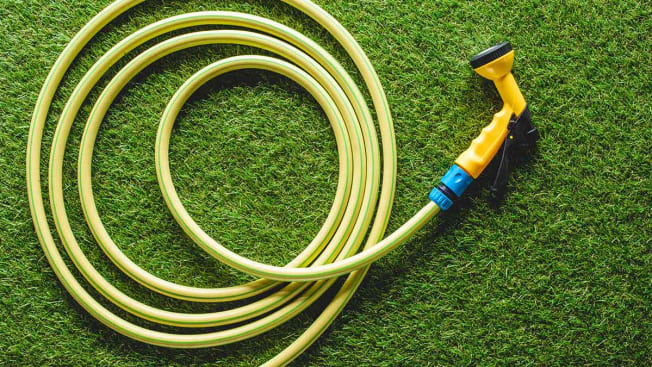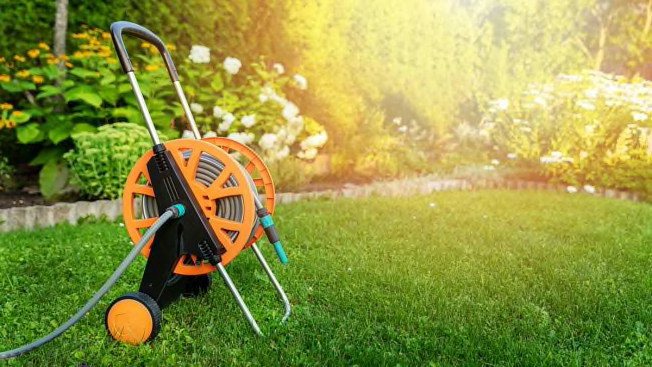Expert Tips for Buying a Garden Hose and Reel
Posted by admin on
Pro tip: Don't get caught up in "no kink" water hose claims. One gardening pro we spoke with says any hose can kink if not cared for properly.

By Jodi Gonzalez
Gardening season is in full swing, with pros and newbies alike snapping up seeds, pots, soil, and mulch to get this year’s crop started. Making plans for raising a bounty of vegetables, herbs, and flowers requires a plan for proper care, and hoses and a place to store them are key components of that plan.
You might think a hose is a hose is a hose, however, you can find a wide variety of hoses and hose reels that come in different materials and lengths and are best suited for different tasks. Before we break down which kinds of hoses work best for which jobs, there are some basic guidelines for any garden hose you buy.
Gardening expert and author Ron Daniels has been growing plants and flowers for about 50 years. His book, “Rose Therapy: My Journey of Growing and Caring for Roses,” highlights his love of roses, which has been his gardening focus for the last 30 years. Daniels has taken many a garden hose and hose reel for a test drive while cultivating his gardening skills. Here are some of his tips on best practices for hoses:
- Get a hose of at least 100 feet for its reach.
- Get a hose with a diameter of at least ⅝ inch. Anything smaller won’t produce enough adequate pressure. Most sprayer attachments are made to fit a ⅝-inch hose, though adapters are available.
- Don’t get hung up on the “no kink” label. “There’s no such thing as a no-kink,” Daniels says. “They all kink if you don’t take care of them.”
- Look for brass fittings on both ends of the hose. Those are less likely to rust.
- Completely drain them of water and store them in a hose reel when not in use and definitely before any extreme heat or cold sets in.
Types of Hoses
Gardening hoses can be found in several types of materials that can be used for specific needs.
PVC/Vinyl Hoses
These are the least expensive, around $40 and up, depending on how many “ply,” or layers, make up the tubing. The more layers the hose has, the less likely it is that the hose will spring a leak, Daniels says.
Most vinyl hoses are best suited to light garden work and washing cars. They don’t have a long life, however. “You might get one season of use out of them,” Daniels says. “They are almost like a throwaway hose.”
Rubber Hoses
Rubber hoses are slightly more expensive. They start around $50 and can carry a price tag in the hundreds of dollars, depending on features. According to lawn care expert Rhys Charles, rubber is the choice for many industrial and commercial jobs because these hoses are flexible, durable, resistant to cracks, and can carry chemicals without compromising the hose’s integrity. These hoses are best suited for big gardening jobs that don’t need a lot of pressure, Charles says.
Be sure to store rubber hoses out of the direct sunlight to prevent damage. Rubber is also heavier than PVC by a couple of pounds, something to consider if you will need to move the hose often or a good distance. Whereas a PVC hose has a limit of around 200 pounds per square inch (psi), a rubber hose can handle pressure up to 300 psi in bursts.
Combination or Hybrid Hoses
Hybrid options are made of rubber and reinforced with a vinyl weave, like tire cording. This mix is lighter to carry around than a 100 percent rubber hose and stronger than a vinyl-only hose. Cost generally falls between that of a good-quality PVC hose and that of a solid rubber model.
These hoses are a good option when budget is a consideration, but strength and flexibility are important. This type of hose has an overall psi of 200 and is capable of bursts up to 600 psi. Combo hoses are a wallet-friendly choice for giving plants a quick drink, washing your car or giving your dogs a bath, Daniels says.
Stainless Steel Braided Hoses
Looking for a hose that can withstand high temps and major pressure? Stainless, braided steel might be for you. These hoses boast superior strength and corrosion resistance, are extremely flexible, and can handle temperatures up to 700° F and pressure from 500 to 10,000 psi, according to Charles. Surprisingly, because stainless steel is a poor conductor of heat, this type of hose won’t get too hot to the touch when left in the sun or when hot water is run through it.
This might seem a bit much for gardening needs, but these hoses are well-suited for warmer climates and for other applications, such as pressure washing. Pricing is comparable to that of rubber hoses, with the advantage of not breaking down in sunlight.
No matter the material used to make them, garden hoses also can be classified by use. Most hoses on the market are considered all-purpose and easily hook up to a sprinkler for your lawn or a number of attachments for your garden. You can even use them to fill up your pool. Other hoses have a specific task or feature that sets them apart.
Expandable Hoses
The name says it all: This type of hose expands when water fills it and contracts once the water is turned off. Expandable hoses are about a third of the overall length before being filled with water. They are also much lighter than other types of hoses, which is useful if you have to move the hose longer distances.
On the cons side, expandable hoses require strong water pressure to work properly. Like all hoses, you have to ensure that all water is drained when you’re not using the hose. Expandable models also are susceptible to damage when left in the sun or in extreme winter weather. They must be stored properly or they won’t last, Daniels says.
Soaker Hoses
These slow-drip hoses keep water on the ground, reducing evaporation, according to Daniels. Because water is going directly into the roots and not on plant leaves or blooms, the risk of fungus issues is also reduced.
You can run soaker hoses on the ground or under it, and they are available in PVC or rubber. As with all-purpose hoses, the PVC soaker varieties typically last only a season or so and are less able to withstand strong water pressure than those made of rubber. Prices start around $40 for a 100-foot hose.
Sprinkler Hoses
Whereas soakers slowly drip water into a plant’s root system, sprinkler hoses have tiny holes along their length and spray water onto grass or other plants rather than keeping the watering only to the roots.
These are good for small patches of lawn when you aren’t able to water by hand or would rather not. The disadvantage of sprinkler hoses is that by spraying above ground a bit (how much is controlled by how high you turn up the pressure), you will have some evaporation and water waste. Sprinkler hoses are usually made of vinyl and are fairly inexpensive. Even though they are flat and release water slowly, they will still need to be drained and stored the right way to ensure any longevity.
Hose Reels
So what is the best way to store any and all of your garden hoses? On a hose reel. Not only will this look tidy, you also will be less likely to have water left in the hose, as the act of rolling up a hose on a reel will force any lingering water out. That means less chance of breeding dangerous pathogens and less chance of weather-related damage to the hose. Not all reels are created equally, however. Daniels offers tips that apply to any of the several types of hose reels out there, and all should meet certain criteria for effectiveness.

Photo: Getty Images
Size: Reels must be able to handle the diameter and length of the hose you wish to store on it. If it is too small, the hose will bunch up and be difficult to wind up and to remove. Too large and it will also be unwieldy.
Construction: You can buy plastic or metal models. There can be a big difference in the plastic’s sturdiness, so look for either heavy-duty plastic or, preferably, a metal reel for durability.
Wall-Mounted Reels
This type of hose reel attaches directly to the outside or your home or garage wall. You can buy them either with a handle to wind up the hose (around $50 and up) or without a handle, requiring that you manually wind the hose (starting around $10).
Self-winding gives you more control over how the hose is wrapped, and that can make it easier to unwind when it’s time to use the hose again, Daniels says. Wall-mounted units keep hoses looking tidy and out of the way when not in use.
Freestanding Hose Reels
Several types are available in this category. One sits on a sort of plant stake, with metal legs that push into the ground for stability. These start around $55 and could come in handy if you use your hoses frequently but want to get them off the ground between jobs. A disadvantage is that this type is not mobile, and you will still need to store your hoses out of the elements during extreme weather.
Next is a plastic or metal reel, with or without a crank handle, that stands on a base and can be picked up and moved around your yard and then into a garage or shed for longer storage. You can even buy one that looks like a box and completely hides the hoses, though winding and unwinding can be difficult with this type.
Some models even come with wheels, making it easier to move the hoses as needed. This is particularly welcome when using long hoses made of heavier material, such as rubber.
For both garden hoses and the reels used to store them, your best bet is to weigh your needs and preferences with budget considerations and performance particulars, then tackle your lawn care with confidence.
Consumer Reports is an independent, nonprofit organization that works side by side with consumers to create a fairer, safer, and healthier world. CR does not endorse products or services, and does not accept advertising. Copyright © 2023, Consumer Reports, Inc.
